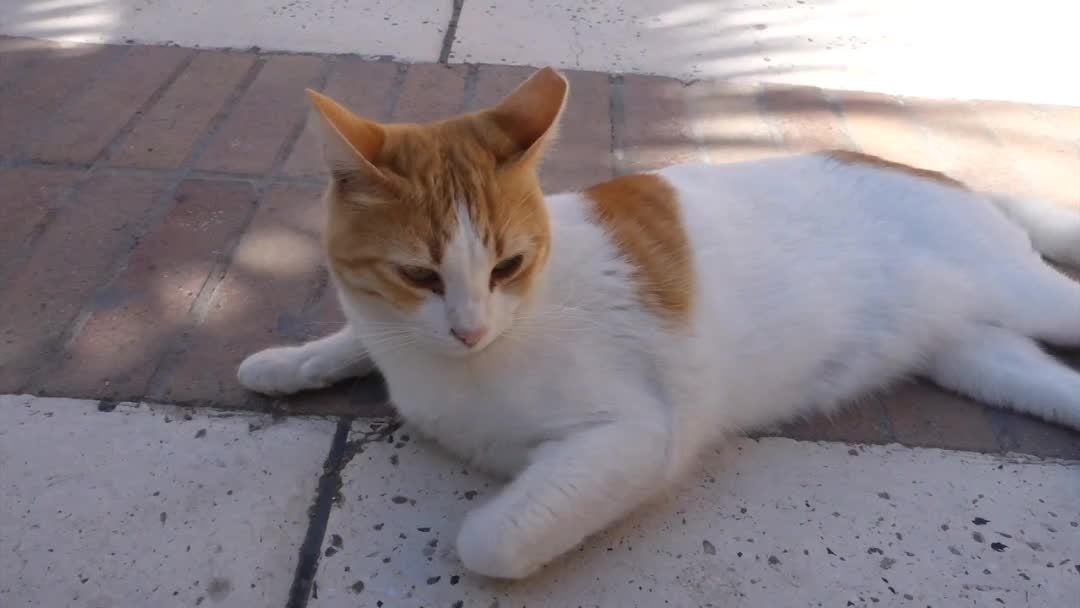Premium Only Content

Cute cat playing outdoors
Cats are common pets throughout the world, and their worldwide population as of 2007 exceeded 500 million.[185] Cats have been used for millennia to control rodents, notably around grain stores and aboard ships, and both uses extend to the present day.[186][187]
As well as being kept as pets, cats are also used in the international fur trade[188] and leather industries for making coats, hats, blankets, and stuffed toys;[189] and shoes, gloves, and musical instruments respectively[190] (about 24 cats are needed to make a cat-fur coat).[191] This use has been outlawed in the United States since 2000 and in the European Union (as well as the United Kingdom) since 2007.[192]
Cat pelts have been used for superstitious purposes as part of the practice of witchcraft,[193] and are still made into blankets in Switzerland as traditional medicine thought to cure rheumatism.[194]
A few attempts to build a cat census have been made over the years, both through associations or national and international organizations (such as that of the Canadian Federation of Humane Societies[195]) and over the Internet,[196][197] but such a task does not seem simple to achieve. General estimates for the global population of domestic cats range widely from anywhere between 200 million to 600 million.[198][199][200][201][202] Walter Chandoha made his career photographing cats after his 1949 images of Loco, an especially charming stray taken in, were published around the world. He is reported to have photographed 90,000 cats during his career and maintained an archive of 225,000 images that he drew from for publications during his lifetime.[203]
Shows
Main article: Cat show
A cat show is a judged event in which the owners of cats compete to win titles in various cat-registering organizations by entering their cats to be judged after a breed standard.[204] It is often required that a cat must be healthy and vaccinated in order to participate in a cat show.[204] Both pedigreed and non-purebred companion ("moggy") cats are admissible, although the rules differ depending on the organization. Competing cats are compared to the applicable breed standard, and assessed for temperament.[204]
Infection
Main article: Feline zoonosis
Cats can be infected or infested with viruses, bacteria, fungus, protozoans, arthropods or worms that can transmit diseases to humans.[205] In some cases, the cat exhibits no symptoms of the disease.[206] The same disease can then become evident in a human. The likelihood that a person will become diseased depends on the age and immune status of the person. Humans who have cats living in their home or in close association are more likely to become infected. Others might also acquire infections from cat feces and parasites exiting the cat's body.[205][207] Some of the infections of most concern include salmonella, cat-scratch disease and toxoplasmosis.[206]
History and mythology
Main articles: Cultural depictions of cats and Cats in ancient Egypt
In ancient Egypt, cats were worshipped, and the goddess Bastet often depicted in cat form, sometimes taking on the war-like aspect of a lioness. The Greek historian Herodotus reported that killing a cat was forbidden, and when a household cat died, the entire family mourned and shaved their eyebrows. Families took their dead cats to the sacred city of Bubastis, where they were embalmed and buried in sacred repositories. Herodotus expressed astonishment at the domestic cats in Egypt, because he had only ever seen wildcats.[208]
Ancient Greeks and Romans kept weasels as pets, which were seen as the ideal rodent-killers. The earliest unmistakable evidence of the Greeks having domestic cats comes from two coins from Magna Graecia dating to the mid-fifth century BC showing Iokastos and Phalanthos, the legendary founders of Rhegion and Taras respectively, playing with their pet cats. The usual ancient Greek word for 'cat' was ailouros, meaning 'thing with the waving tail'. Cats are rarely mentioned in ancient Greek literature. Aristotle remarked in his History of Animals that "female cats are naturally lecherous." The Greeks later syncretized their own goddess Artemis with the Egyptian goddess Bastet, adopting Bastet's associations with cats and ascribing them to Artemis. In Ovid's Metamorphoses, when the deities flee to Egypt and take animal forms, the goddess Diana turns into a cat.[209][210]
Cats eventually displaced weasels as the pest control of choice because they were more pleasant to have around the house and were more enthusiastic hunters of mice. During the Middle Ages, many of Artemis's associations with cats were grafted onto the Virgin Mary. Cats are often shown in icons of Annunciation and of the Holy Family and, according to Italian folklore, on the same night that Mary gave birth to Jesus, a cat in Bethlehem gave birth to a kitten.[211] Domestic cats were spread throughout much of the rest of the world during the Age of Discovery, as ships' cats were carried on sailing ships to control shipboard rodents and as good-luck charms.[50]
Several ancient religions believed cats are exalted souls, companions or guides for humans, that are all-knowing but mute so they cannot influence decisions made by humans. In Japan, the maneki neko cat is a symbol of good fortune.[212] In Norse mythology, Freyja, the goddess of love, beauty, and fertility, is depicted as riding a chariot drawn by cats.[213] In Jewish legend, the first cat was living in the house of the first man Adam as a pet that got rid of mice. The cat was once partnering with the first dog before the latter broke an oath they had made which resulted in enmity between the descendants of these two animals. It is also written that neither cats nor foxes are represented in the water, while every other animal has an incarnation species in the water.[214] Although no species are sacred in Islam, cats are revered by Muslims. Some Western writers have stated Muhammad had a favorite cat, Muezza.[215] He is reported to have loved cats so much, "he would do without his cloak rather than disturb one that was sleeping on it".[216] The story has no origin in early Muslim writers, and seems to confuse a story of a later Sufi saint, Ahmed ar-Rifa'i, centuries after Muhammad.[217] One of the companions of Muhammad was known as Abu Hurayrah ("father of the kitten"), in reference to his documented affection to cats.[218]
The ancient Egyptians mummified dead cats out of respect in the same way that they mummified people[4]
Ancient Roman mosaic of a cat killing a partridge from the House of the Faun in Pompeii
A 19th-century drawing of a tabby cat
Superstitions and rituals
Some cultures are superstitious about black cats, ascribing either good or bad luck to them
Many cultures have negative superstitions about cats. An example would be the belief that encountering a black cat ("crossing one's path") leads to bad luck, or that cats are witches' familiars used to augment a witch's powers and skills. The killing of cats in Medieval Ypres, Belgium, is commemorated in the innocuous present-day Kattenstoet (cat parade).[219] In mid-16th century France, cats would be burnt alive as a form of entertainment. According to Norman Davies, the assembled people "shrieked with laughter as the animals, howling with pain, were singed, roasted, and finally carbonized".[220]
James Frazer wrote that "It was the custom to burn a basket, barrel, or sack full of live cats, which was hung from a tall mast in the midst of the bonfire; sometimes a fox was burned. The people collected the embers and ashes of the fire and took them home, believing that they brought good luck. The French kings often witnessed these spectacles and even lit the bonfire with their own hands. In 1648 Louis XIV, crowned with a wreath of roses and carrying a bunch of roses in his hand, kindled the fire, danced at it and partook of the banquet afterwards in the town hall. But this was the last occasion when a monarch presided at the midsummer bonfire in Paris. At Metz midsummer fires were lighted with great pomp on the esplanade, and a dozen cats, enclosed in wicker cages, were burned alive in them, to the amusement of the people. Similarly, at Gap, in the department of the Hautes-Alpes, cats used to be roasted over the midsummer bonfire."[221]
According to a myth in many cultures, cats have multiple lives. In many countries, they are believed to have nine lives, but in Italy, Germany, Greece, Brazil and some Spanish-speaking regions, they are said to have seven lives,[222][223] while in Arabic traditions, the number of lives is six.[224] The myth is attributed to the natural suppleness and swiftness cats exhibit to escape life-threatening situations.[citation needed] Also lending credence to this myth is the fact that falling cats often land on their feet, using an instinctive righting reflex to twist their bodies around. Nonetheless, cats can still be injured or killed by a high fall.
-
 LIVE
LIVE
Welsh Girl
6 hours ago🔴 Minecraft Basics Explained – DAY 1
106 watching -
 DVR
DVR
SynthTrax & DJ Cheezus Livestreams
1 day agoFriday Night Synthwave 80s 90s Electronica and more DJ MIX Livestream Trip-Hop SPECIAL EDITION
34.2K1 -
 4:03:27
4:03:27
FusedAegisTV
10 hours agoRumble Smackdown! #001 Street Fighter 6 $500 Online Tournament
63K7 -
 55:58
55:58
BonginoReport
7 hours agoCan Trump Make TikTok Great Again? (Ep. 20) - Nightly Scroll with Hayley Caronia - 04/04/25
130K80 -
 LIVE
LIVE
Jorba4
3 hours ago🔴Live-Jorba4- COD WARZONE- VERDANSK FRIDAY. Hot drops W/ XxXAztecWarrior and Lumpy Potato X2
166 watching -
 4:33:11
4:33:11
Nerdrotic
9 hours ago $31.99 earnedPost-Apocalyptic Woke Hollywood, MineCRAP, CinemaCONNED - Friday Night Tights 348, Chris Gore & Rags
115K16 -
 1:00:43
1:00:43
Sarah Westall
6 hours agoThe Greatest Financial Crime in History: How Globalist Central Bankers Did It w/ James Patrick
66.3K2 -
 4:44:07
4:44:07
IamTyrantt
5 hours ago $1.25 earnedTGIF! HIGH ENERGY VIBES!
35.6K1 -
 13:19
13:19
China Uncensored
7 hours agoHow Trump's New Tariffs Are CRUSHING China's Economy
34.6K16 -
 1:23:47
1:23:47
Kim Iversen
9 hours agoAre Patriots Are Being Deceived? Why Trump and Elon Might Be the Globalists' Greatest Weapons
120K181